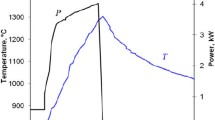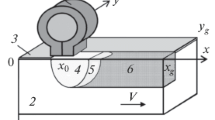Abstract
The microwave heating of materials is important in many industrial processes. For example, it is used for the smelting of metals and the sintering of ceramics. Hot-spots (localised areas of high temperature) can develop in the material being heated or in the microwave oven itself, with disastrous consequences. Impurities in the material or in a component of the microwave oven can have different electromagnetic and thermal properties to the surrounding material. Different rates of heating occur at these sites, which gives rise to differential heating, which can lead to the generation of hot-spots. The generation of hot-spots by this mechanism is considered for a finite one-dimensional slab with a single impurity at its centre. A fixed-temperature boundary condition is applied at both ends of the slab and one end of the slab is irradiated by microwaves of constant amplitude. The heat absorption at the impurity is assumed to have a power-law dependence on temperature (hence hot-spot generation can occur via thermal runaway). Depending on the electrical and thermal properties of the material there are two possibilities; either a hot-spot occurs or a steady-state solution occurs due to a balance between heat absorption in the material and heat loss through the boundaries. These steady-state solutions are found for both linear and non-linear thermal absorptivity and constant and decaying electric-field amplitude. If possible the region of parameter space in which they occur (in the rest of the parameter space hot-spots occur) is also found. In addition, numerical solutions are developed to verify the steady-state solutions and to investigate cases where analytical solutions are difficult to derive, such as for materials with multiple impurities.
Similar content being viewed by others
References
A.S. Metaxas and R.J. Meredith, Industrial Microwave Heating. IEE Power Engineering Series, 4, P. Peregrinus on behalf of the Institution of Electrical Engineers, London (1983).
G. A. Kriegsmann, M. E. Brodwin and D. G.Watters, Microwave heating of a ceramic halfspace. SIAM J. Appl. Math. 50 (1990) 1088–1098.
G. A. Kriegsmann, Thermal runaway in microwave heated ceramics: a one-dimensional model. J. Appl. Phys. 71 (1992) 1960–1966.
A. H. Pincombe and N. F. Smyth, Microwave heating of materials with low conductivity. Proc. Roy. Soc. Lond. A 433 (1991) 479–498.
N. F. Smyth, Microwave heating of bodies with temperature dependent properties. Wave Motion 12 (1990) 171–186.
T. R. Marchant and A.H. Pincombe, Microwave heating of materials with temperature dependent wavespeed. Wave Motion (1994) to appear.
G. Roussy, A. Bennani and J. Thiebaut, Temperature runaway of microwave irradiated materials. J. Appl. Phys. 62 (1987) 1167–1170.
M. E. Brodwin, G. A. Kriegsmann and D. G. Watters, Temperature instability in the microwave heating of a uniformly illuminated planar slab. IEEE (1994) to appear.
C. J. Coleman, On the microwave hotspot problem. J. Aust. Math. Soc. B 33 (1991) 171–186.
J. M. Hill and N. F. Smyth, On the mathematical analysis of hotspots arising from microwave heating. Math. Eng. in Industry 2 (1990) 267–278.
N. F. Smyth, The effect of conductivity on hot-spots. J. Austral. Math. Soc. B 33 (1992) 403–413.
J. M. Hill and M. J. Jennings, Formulation of model equations for heating by microwave radiation. Appl. Math. Modelling 17 (1993) 1823–1834.
R. Haberman, Elementary Applied Partial Differential Equations. Prentice-Hall, New Jersey (1983).
J. M. Hill and A. H. Pincombe, Some similarity profiles for the microwave heating of a half-space. J. Austral. Math. Soc. Ser. B 33 (1991) 290–320.
A. R. Von Hippel, Dielectric Materials and Applications. MIT Press, Cambridge, MA (1954).
Author information
Authors and Affiliations
Rights and permissions
About this article
Cite this article
Marchant, T.R. Microwave heating of materials with impurities. J Eng Math 28, 379–400 (1994). https://doi.org/10.1007/BF00058461
Received:
Accepted:
Issue Date:
DOI: https://doi.org/10.1007/BF00058461




